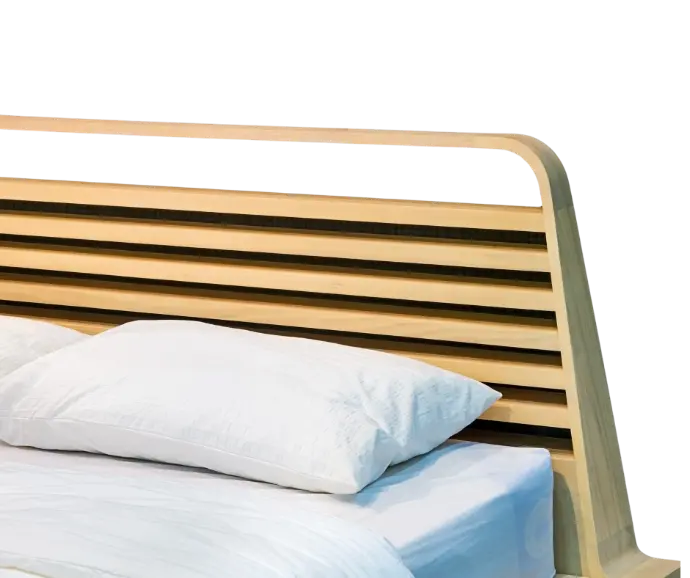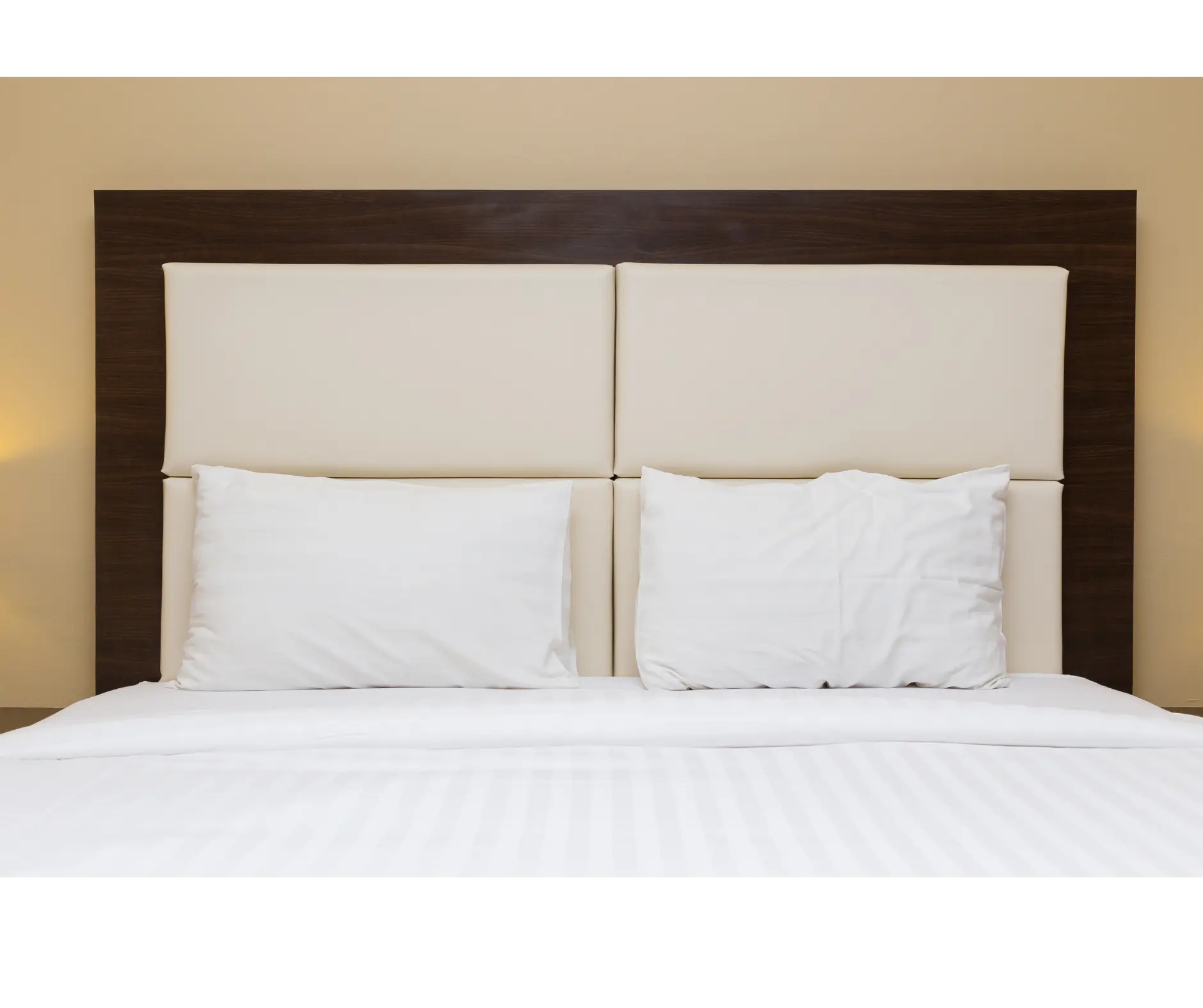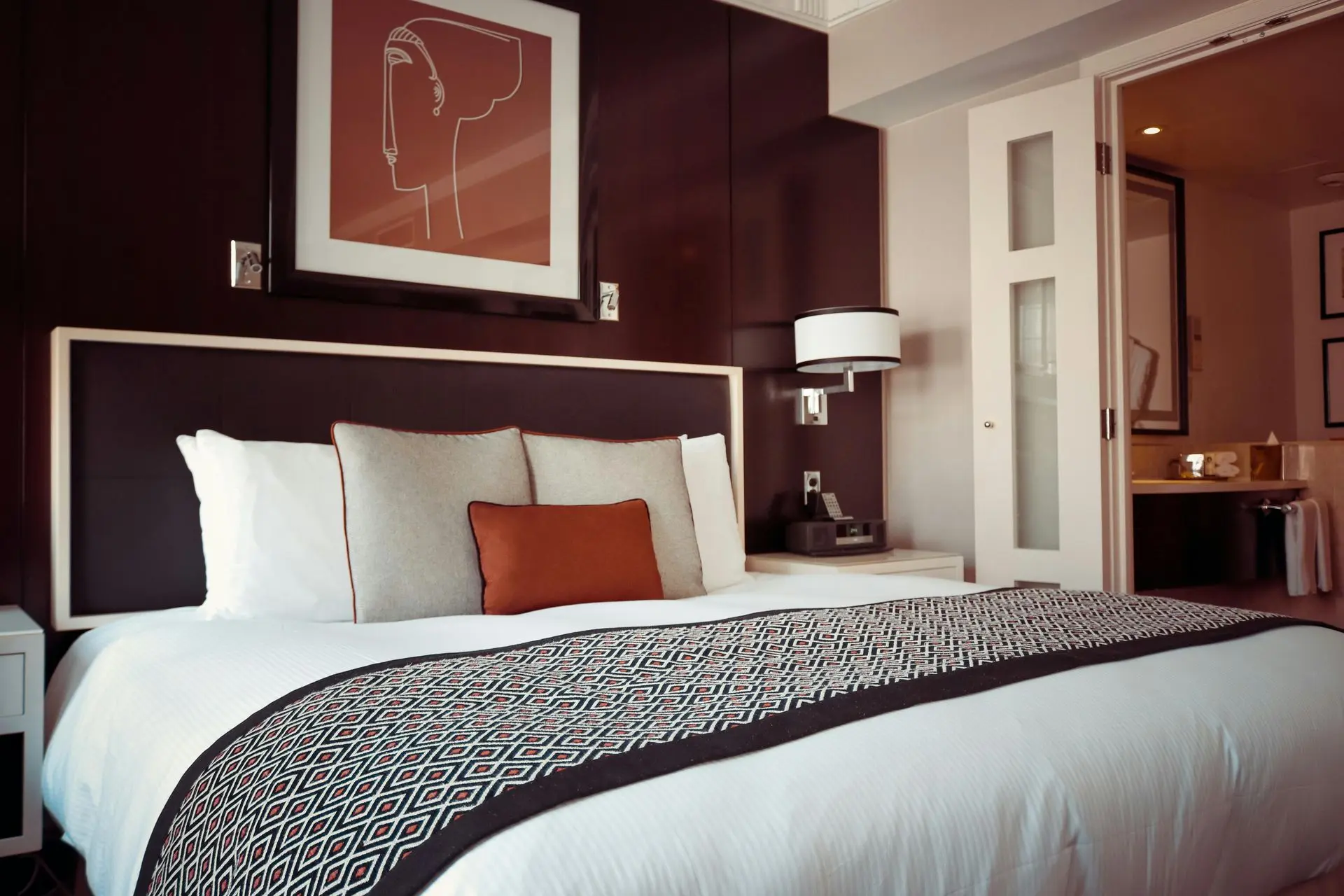Hotel Headboards
We supply high-quality headboards for Hospitality Clients all around the world.
Request a Quotation
Headboards
When you step into a beautifully designed hotel room, your eyes are naturally drawn to the bed—the centerpiece of the space. But it’s not just the crisp linens or perfectly arranged pillows that make it memorable; the headboard plays a pivotal role in defining the room's character and enhancing guest comfort. From plush, upholstered panels that exude luxury to minimalist designs that embody modern elegance, headboards are more than a decorative element—they’re a statement of style and functionality.
In hotel design, headboards serve multiple purposes. Visually, they anchor the bed and often act as the focal point of the room, setting the tone for its aesthetic. Functionally, they provide ergonomic support for guests who sit up in bed to read, work, or relax. They can even incorporate features like built-in lighting or storage to maximize convenience.
This guide explores everything you need to know about hotel headboards: why they matter, popular styles, material choices, customization options, and how to select the perfect one for your property. Whether you’re aiming for timeless elegance or cutting-edge design, the right headboard can transform a guest room into an unforgettable retreat.
Why Hotel Headboards Matter
Hotel headboards hold a significance that extends far beyond mere aesthetic enhancement; they actively contribute to the guest's overall comfort, play a crucial role in defining the room's design narrative, and even offer a range of practical benefits that enhance the stay.
Firstly, a thoughtfully designed headboard naturally establishes itself as the visual focal point within the hotel room. It acts as a central anchor, drawing the eye and effectively tying together the various elements of the décor. This cohesive visual presence is instrumental in creating a lasting impression on the guest, contributing significantly to their perception of the room's style and overall ambiance.
Beyond aesthetics, headboards directly impact the comfort and functionality experienced by guests. Recognizing that many guests engage in activities such as reading, working, or watching television while seated in bed, a padded headboard offers essential back support. This ergonomic consideration enhances the guest's comfort and promotes relaxation during their time spent in the room.
Furthermore, headboards serve important practical functions related to the upkeep and cleanliness of the room. By acting as a protective barrier between the bed and the wall, they effectively prevent scuffs and stains that can occur over time. Additionally, they offer a degree of insulation, shielding guests from the potentially cold and uninviting surface of the wall, thereby contributing to a more comfortable and inviting sleeping environment.
Finally, certain types of headboards, particularly those featuring upholstery, offer the added advantage of noise reduction. The soft, padded materials possess sound-dampening qualities, helping to muffle noises originating from adjacent rooms or external sources. This contributes significantly to the overall tranquility and peacefulness of the guest room, fostering a more restful and enjoyable experience for the hotel's valued guests.
Types of Hotel Headboards
Choosing the right type of hotel headboard depends on the design vision, functionality needs, and budget. Here are some popular styles:
- Wall-Mounted Headboards: These headboards are fixed directly to the wall and are popular in modern hotels. They offer design flexibility and save floor space. Many upscale hotels use large wall-mounted headboards that stretch beyond the bed width, creating a luxurious, custom-built feel.
- Floor-Standing Headboards: Freestanding and often more substantial, these headboards attach to the bed frame or stand independently. They’re sturdy, easy to move during renovations, and ideal for properties that frequently change room layouts.
- Panel Headboards: Made of multiple segments, panel headboards offer a modern, geometric look. They can be upholstered or made from wood, leather, or other materials for a textured visual effect.
- Wingback Headboards: These headboards have side panels that curve forward like wings, creating a cocoon-like feeling. They're perfect for luxury and boutique hotels aiming for an upscale, intimate atmosphere.
- Extended or Wall-to-Wall Headboards: For dramatic impact, many designers opt for headboards that extend behind nightstands or across the entire wall. This creates cohesion in the room’s layout and a high-end, custom look.


Common Materials Used in Hotel Headboards
When selecting headboards for hotels, the choice of materials is crucial for ensuring durability, enhancing appearance, and simplifying maintenance. Here are some of the most popular options:
Upholstered Fabric Headboards: Fabric headboards are a guest favorite due to their soft and inviting nature. Popular fabrics include:
- Velvet: Known for adding elegance and a plush feel, velvet is ideal for creating a luxurious ambiance.
- Linen: Breathable and sophisticated, linen headboards bring a light, airy feel to the room.
- Faux Leather: Durable and easy to clean, faux leather offers a sleek, modern look that suits contemporary hotels.
- Polyester Blends: Affordable and stain-resistant, polyester blends are perfect for high-traffic rooms where practicality is key.
Wooden Headboards: Wooden headboards are timeless and versatile, bringing natural warmth to any room. They come in a range of finishes, from light oak to rich walnut, and can be designed in minimalist or ornately carved styles to suit various hotel themes.
Metal Headboards: Metal headboards are often used in industrial or minimalist hotels due to their durability and ease of cleaning. Powder-coated finishes or brass accents can elevate their style, making them a chic addition to modern spaces.
Laminated or Veneered Boards: For a cost-effective yet stylish option, laminated or veneered boards are ideal. Laminate mimics the appearance of wood or stone while being scratch- and moisture-resistant, making it perfect for large hotel chains focused on longevity and low maintenance.
Customization Options for Hotel Headboards
Customizing hotel headboards offers a powerful opportunity to seamlessly integrate them with your brand narrative and interior design aspirations. A range of options allows for a personalized touch that elevates both aesthetics and functionality:
- Color and Finish Alignment: Achieve perfect harmony with your established brand palette by selecting bespoke fabric colors for upholstered headboards or specifying unique wood finishes for timber designs. This ensures a cohesive visual identity throughout your guest rooms.
- Integrated Lighting Solutions: Enhance both the practicality and ambiance of your rooms by incorporating integrated lighting. Options include focused reading lights for bedside convenience, subtle ambient backlighting to create a relaxing mood, or modern LED accents to add a touch of contemporary style.
- Space-Saving Built-in Features: Maximize efficiency and style, particularly in rooms with limited square footage, by opting for headboards with integrated nightstands or shelving units. These seamlessly incorporated elements provide functionality without compromising the room's aesthetic.
- Incorporating Branding and Local Flair: Reinforce your hotel's unique identity by adding subtle branding elements. This can include embossing logos or signature patterns into fabric upholstery or integrating unique design motifs that subtly reflect the local culture and surroundings, offering guests a more memorable and authentic experience.
- Integrating Modern Connectivity: Cater to the needs of today's tech-savvy travelers by including built-in USB ports and power outlets directly into the headboard design. This thoughtful amenity provides convenient charging solutions, enhancing guest comfort and satisfaction.

Factors to Consider When Sourcing Hotel Headboards
When selecting headboards for your hotel rooms, a strategic approach that goes beyond mere visual appeal is crucial. To ensure a sound investment that enhances guest satisfaction and operational efficiency, carefully evaluate the following key factors:
- Durability: Hotel furnishings endure significant and frequent use. Prioritize robust materials and sturdy construction methods to withstand frequent cleaning protocols and the daily demands of guest use. Opt for fabrics specifically designed for commercial applications, emphasizing stain resistance and resilience to wear and tear. Ensure the structural integrity of the headboard itself for long-term performance.
- Ease of Maintenance: Streamlined housekeeping is essential for efficient hotel operations. Select headboards designed for easy maintenance, featuring removable and washable covers or surfaces that can be quickly and effectively wiped clean. This minimizes cleaning time and labor costs, contributing to overall operational efficiency and ensuring a consistently presentable guest room.
- Safety and Compliance: Guest safety is paramount. Ensure that all sourced headboards are manufactured using fire-retardant materials to meet safety regulations and minimize potential hazards. Additionally, consider designs that incorporate rounded or softened edges to reduce the risk of accidental injury to guests. Adherence to all relevant safety standards and compliance requirements is non-negotiable.
- Acoustic Performance: In urban locations or properties situated near noise sources like airports, creating a peaceful and restful environment is crucial for guest satisfaction. Consider the acoustic properties of headboard designs. Padded or fully upholstered headboards can effectively dampen sound transmission between rooms and from external sources, contributing to a more tranquil and comfortable stay experience.
- Budget and Lifecycle Cost: While initial budgetary constraints are a consideration, a smart sourcing strategy evaluates the long-term financial implications. Investing in higher-quality, more durable, and low-maintenance headboards may involve a greater upfront cost. However, the extended lifespan and reduced need for frequent replacements, coupled with lower maintenance expenses, can ultimately lead to significant cost savings over the lifecycle of the furniture, representing a more sustainable and financially sound investment.
Trends in Hotel Headboard Design
Hotel design is a dynamic field, constantly evolving to meet the changing expectations and preferences of travelers. Headboards, as prominent features within guest rooms, are no exception to these trends. Several innovative ideas are currently gaining significant popularity in hotel headboard design, reflecting a broader shift towards more personalized, sustainable, and technologically integrated spaces.
One notable trend is the increasing adoption of eco-friendly materials. In alignment with the growing emphasis on sustainable hospitality practices, designers are incorporating materials such as bamboo, recycled wood, and organic fabrics into headboard designs. These choices not only contribute to a reduced environmental footprint but also often bring a unique natural aesthetic and a sense of responsible luxury to the guest room.
Another prominent trend involves the incorporation of textured fabrics. Moving beyond smooth, conventional upholstery, designers are embracing materials like bouclé, employing techniques such as channel tufting, and utilizing quilted finishes to add a rich tactile appeal and enhanced visual depth to the headboard. These textures create a more inviting and sensory-rich environment, contributing to a greater sense of comfort and visual interest.
The creative combination of mixed materials is also gaining traction in hotel headboard design. Designers are experimenting with juxtaposing contrasting materials, such as pairing the warmth of wood with the sleekness of metal, or layering the richness of leather with the softness of upholstery. This intentional layering of textures and materials adds a sophisticated dimension and a more visually dynamic element to the bed and the overall room design.
In the realm of luxury hospitality, the integration of smart technology into headboards is an emerging trend. Some high-end hotels are incorporating intuitive smart controls directly into the headboard design, allowing guests to conveniently manage various aspects of their room environment, such as lighting levels, curtain operation, and even temperature adjustments, all within easy reach from the comfort of their bed.
Finally, there is a growing movement towards art-inspired designs. Breaking away from standardized, mass-produced furniture, hotels are increasingly opting for headboards featuring abstract shapes, bold and eye-catching patterns, and collaborations with local artisans to showcase unique craftsmanship. This trend injects personality and character into the guest room, often reflecting the local culture and providing a more memorable and authentic experience that moves beyond generic hotel aesthetics.
Why Source Hotel Headboards from China?
China has become a leading source for hotel headboards thanks to its combination of high-quality craftsmanship, extensive customization options, and competitive pricing. Manufacturers in China offer diverse styles, materials, and design capabilities, enabling hotels to tailor headboards to exact specifications—whether for a boutique property or a global hotel chain. With streamlined manufacturing and export experience, Chinese suppliers can meet international safety and quality standards, ensuring consistent product reliability.
Additionally, China’s advanced supply chain infrastructure allows for efficient bulk production and shipping, helping reduce lead times and costs. From modern upholstered panels to custom wood or metal designs with integrated tech features, sourcing from China offers unmatched value. With a trusted partner like Deper Hospitality, you gain access to verified manufacturers, transparent communication, and end-to-end support to ensure the headboards align with your brand vision and guest expectations.
Conclusion
The selection of hotel headboards is a multifaceted decision that significantly impacts both the aesthetic appeal and the functional comfort of guest rooms. More than just a backdrop for the bed, the headboard serves as a key design element, a source of ergonomic support, and even a practical amenity. By carefully considering the diverse styles, material options, customization possibilities, and crucial sourcing factors outlined in this guide, hoteliers can make informed choices that enhance the guest experience, streamline operations, and align with their brand identity.
As hotel design continues to evolve, embracing trends in eco-friendly materials, textured fabrics, mixed material combinations, smart technology integration, and art-inspired designs, the headboard remains a vital canvas for creativity and innovation. By thoughtfully incorporating these elements, hotels can create memorable and distinctive guest rooms that cater to the modern traveler's expectations for style, comfort, and convenience.
For hoteliers seeking to elevate their guest room design with high-quality, customizable headboard solutions that perfectly blend aesthetics, functionality, and durability, Deper Hospitality stands ready to be your trusted partner. With our extensive expertise in crafting bespoke furniture for the hospitality industry, we understand the unique demands of hotel environments and are committed to providing headboards that not only enhance the visual appeal of your rooms but also contribute to exceptional guest satisfaction. Contact us today to explore our wide range of headboard options and discover how we can help you create unforgettable guest experiences.
Ready to embark on a journey redefined hospitality products?
Contact us today to learn more about our customization options and to request a quote.